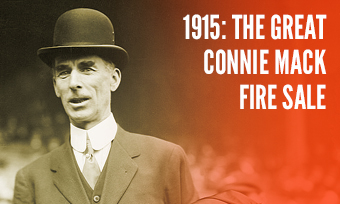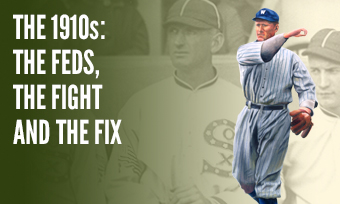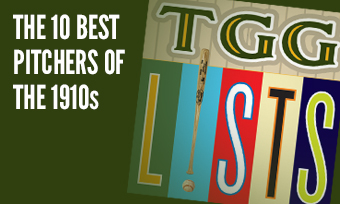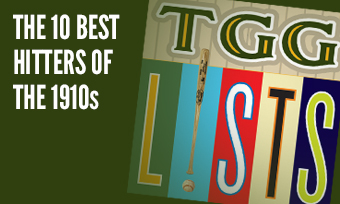The Yearly Reader
Leaders and Honors, 1915
Our list of baseball’s top 10 hitters and pitchers in both the American League and National League for the 1915 baseball season, as well as the awards and honors given to the game’s top achievers of the year.
The National League’s Top 10 Hitters, 1915
Bold type in brick red indicates league leader.
1. Gavvy Cravath, Philadelphia
Key Numbers: .285 average, 89 runs, 31 doubles, 7 triples, 24 home runs, 115 RBIs, 86 walks, .393 on-base percentage, .510 slugging percentage.
Shades of the future Babe Ruth: Cravath was out-homered by only four other teams in the majors.
2. Larry Doyle, New York
Key Numbers: .320 average, 86 runs, 189 hits, 40 doubles, 10 triples, 70 RBIs.
After an off-year (.260) by his standards, Doyle returned to star form and collecting the only batting title of his career.
3. Bill Hinchman, Pittsburgh
Key Numbers: .307 average, 177 hits, 33 doubles, 14 triples, 77 RBIs.
Batting .238 over five years at Cleveland before a five-year relegation to the minors—where his hitting exploded—Hinchman returned to the majors and, at 32, finally got it.
4. Vic Saier, Chicago
Key Numbers: .264 average, 35 doubles, 11 triples, 11 home runs, 64 walks, 29 stolen bases.
Saier reached double-figures in homers for the third straight year—no small feat in the Deadball Era—but a late-season leg injury signaled the beginning of his decline.
5. Honus Wagner, Pittsburgh
Key Numbers: .274 average, 32 doubles, 17 triples, 6 home runs, 78 RBIs, 22 stolen bases.
At age 41, Wagner had enough juice left to forge one last solid season—leading his team in doubles, triples, home runs and RBIs.
6. Sherry Magee, Boston
Key Numbers: .280 average, 34 doubles, 12 triples, 87 RBIs.
An injury on the first day of spring camp led to a more muted—but still superior—set of numbers in his first year with the Braves.
7. Tommy Griffith, Cincinnati
Key Numbers: 160 games, .307 average, 179 hits, 31 doubles, 16 triples, 85 RBIs.
Appropriately born 120 miles from Cincinnati in the Ohio town of Prospect, Griffith had a sterling full-season debut for the Reds. But it would have helped had he just stayed on base rather than try to swipe a bag; he was only successful in six of 30 stole base attempts.
8. Fred Luderus, Philadelphia
Key Numbers: .315 average, 36 doubles, 7 home runs, 62 RBIs.
The powerful first baseman failed to reach 10 or more homers for the fifth straight year, but compensated with a career-best .315 average.
9. Tom Long, St. Louis
Key Numbers: .294 average, 21 doubles, 25 triples, 19 stolen bases.
One of the few (if, maybe, only) players to play a decent amount of major league ball and finish his career with more triples than doubles, Long led the NL with 25 three-baggers in his first of three full seasons.
10. George Burns, New York
Key Numbers: .272 average, 622 at-bats, 83 runs, 27 doubles, 14 triples, 27 stolen bases.
A slight slump for the Giants’ tablesetter, but he remained effective enough to make the cut here.
The American League’s Top 10 Hitters, 1915
1. Ty Cobb, Detroit
Key Numbers: .369 average, 144 runs, 208 hits, 31 doubles, 13 triples, 99 RBIs, 118 walks, 96 stolen bases, 38 caught stealing, .486 on-base percentage.
Cobb stayed healthy and out of trouble to retain his status as the AL’s premier hitter.
2. Eddie Collins, Chicago
Key Numbers: .332 average, 118 runs, 173 hits, 22 doubles, 10 triples, 77 RBIs, 119 walks, 46 stolen bases.
Along with Joe Jackson (below), Collins was one of two Hall-of-Fame-caliber stars who helped turned typically clueless White Sox hitting around—while thrilling typically exasperated White Sox pitchers.
3. Jack Fournier, Chicago
Key Numbers: 126 games, .322 average, 86 runs, 20 doubles, 18 triples, 77 RBIs, 15 hit-by-pitches, .491 slugging percentage.
Before emerging as an all-around solid hitter with Brooklyn in the 1920s, Fournier experienced the most efficient (and busiest) year of a relatively fleeting major league existence during the 1910s. Note that of all the great names on this list, he outslugged them all.
4. Sam Crawford, Detroit
Key Numbers: .299 average, 81 runs, 183 hits, 31 doubles, 19 triples, 112 RBIs, 24 stolen bases.
Long-time Cobb teammate Crawford, enjoying the last great year of his career, co-led the AL in RBIs with…
5. Bobby Veach, Detroit
Key Numbers: .313 average, 81 runs, 178 hits, 40 doubles, 10 triples, 112 RBIs, 68 walks.
…Tigers teammate Veach, enjoying the first great year of his career.
6. Tris Speaker, Boston
Key Numbers: .322 average, 108 runs, 176 hits, 25 doubles, 10 triples, 81 walks, 29 stolen bases.
In his last year as a Red Sock, Speaker was happy to let pitcher Babe Ruth (four homers in 92 at-bats) do the power thing while hitting none for only one of two times in his long, star-studded career.
7. Ray Chapman, Cleveland
Key Numbers: .270 average, 101 runs, 17 triples, 70 walks, 36 stolen bases.
Five years from meeting his fate against Carl Mays, the proactive Chapman reached peak performance after the White Sox attempted to trade for him. (Chicago had to “settle” for Joe Jackson instead.)
8. Joe Jackson, Cleveland-Chicago
Key Numbers: .308 average, 14 triples, 5 home runs, 81 RBIs.
The shoeless one produced a mild batting average by his standards (some 50 points below his eventual career mark), but the White Sox were all too happy to secure a naturally gifted hitter—something they seemed to had forever lacked.
9. Braggo Roth, Chicago-Cleveland
Key Numbers: .268 average, 109 games, 67 runs, 17 triples, 7 home runs, 26 stolen bases.
Whereas the average of Joe Jackson (above) went down after he was dealt to Chicago, Roth—the main guy going the other way in the trade—punched it up with the Indians, hitting .299 with 14 steals in 39 games.
10. Burt Shotton, St. Louis
Key Numbers: .283 average, 93 runs, 11 triples, 118 walks, 43 stolen bases.
Shotton did everything a leadoff guy was expected to do, placing in the AL’s top five in walks, steals and on-base percentage; he might have also been in the top five for runs had the Browns’ lineup behind him not been so lackluster.
The National League’s Top 10 Pitchers, 1915
1. Pete Alexander, Philadelphia
Key Numbers: 1.22 ERA, 31 wins, 10 losses, .756 win percentage, 36 complete games, 12 shutouts, 376.1 innings, 241 strikeouts.
Pete Alexander never threw a no-hitter, but he repeatedly came close in 1915—throwing four one-hitters.
2. Tom Hughes, Boston
Key Numbers: 2.12 ERA, 16 wins, 14 losses, 9 saves, 50 appearances, 280.1 innings.
No relation to pitcher Long Tom Hughes from a decade earlier, this Hughes went long and short for the Braves by relieving in as many games as he started. He certainly enjoyed the advent of spacious Braves Field, where he posted a 0.38 ERA (and allowed just 16 hits) over 47.2 innings.
3. Jeff Tesreau, New York
Key Numbers: 2.29 ERA, 19 wins, 16 losses, 8 shutouts, 306 innings.
With aging Christy Mathewson and burned-out Rube Marquard both fading out of the Giants’ spotlight, Tesreau took over as New York’s prime ace for the moment.
4. Dick Rudolph, Boston
Key Numbers: 2.37 ERA, 22 wins, 19 losses, 43 starts, 341.1 innings.
The Boston workhorse gave an equally worthy follow-up to his sensational 1914 campaign, even if the wins were harder to come by.
5. Al Mamaux, Pittsburgh
Key Numbers: 2.04 ERA, 21 wins, 8 losses, 8 shutouts.
The Pittsburgh native enjoyed the first of two 21-win seasons before a mid-career collapse.
6. Fred Toney, Cincinnati
Key Numbers: 1.58 ERA, 17 wins, 6 losses, 6 shutouts, .739 win percentage.
After laboring briefly and with little success for the 1911-13 Cubs, Toney returned to the majors as a newborn pitcher; only Pete Alexander allowed a lower opposing batting average than the Nashville native’s .207.
7. Jeff Pfeffer, Brooklyn
Key Numbers: 2.10 ERA, 19 wins, 14 losses, 6 shutouts, 291.2 innings.
Never one to shy away from intimidating opponents, the husky (6’3”, 210 lbs.) Brooklyn ace began a three-year run in which he hit a total of 50 batters.
8. Pat Ragan, Brooklyn-Boston
Key Numbers: 2.34 ERA, 17 wins, 12 losses.
Ragan’s tour of the National League brought him to the Braves after an early-season trade from Brooklyn, making much-needed improvement after going 32-51 with a 3.49 ERA that was substandard for Deadball Era times.
9. Erskine Mayer, Philadelphia
Key Numbers: 2.36 ERA, 21 wins, 15 losses, 274.2 innings.
Like Al Mamaux (above), Mayer won 21 this year and 21 the next before becoming enshrouded in a fog of anonymity.
10. Gene Dale, Cincinnati
Key Numbers: 2.46 ERA, 18 wins, 17 losses, 49 appearances, 35 starts, 20 complete games, 296.2 innings, 107 walks, 26 grounded into double plays.
Dale had a brief taste of glory in Cincinnati before his inability to hit the strike zone got the better of him. Four years later, back in the minors, he’d be expelled from the game along with several others trying to fix the 1919 Pacific Coast League pennant race.
The American League’s Top 10 Pitchers, 1915
1. Walter Johnson, Washington
Key Numbers: 1.55 ERA, 27 wins, 13 losses, 39 starts, 35 complete games, 7 shutouts, 336.2 innings, 203 strikeouts.
The Big Train’s continued mastery of the AL made a lot of folks wonder how invincible he would have been had he fled to the Federal League, as he momentarily did before 1915.
2. Jim Scott, Chicago
Key Numbers: 2.03 ERA, 24 wins, 11 losses, 7 shutouts, 296.1 innings.
Entering the year with a career 2.34 ERA but a losing (70-82) record, Scott finally got way, way overdue offensive support in Chicago thanks to new White Sox arrivals Eddie Collins and Joe Jackson.
3. Harry Coveleski, Detroit
Key Numbers: 2.45 ERA, 22 wins, 13 losses, 50 appearances, 312.2 Innings.
In a decade in which the Tigers excelled with great hitting but poor pitching, Coveleski made great gains toward making the 1915 season an exception to the rule.
4. Ernie Shore, Boston
Key Numbers: 1.64 ERA, 19 wins, 8 losses, 247 innings.
The second-year right-hander fashioned a great campaign with a career-high total of wins and the AL’s third-best ERA.
5. Smoky Joe Wood, Boston
Key Numbers: 1.49 ERA, 15 wins, 5 losses, .750 win percentage.
Long since unable to ply his trade as a workhorse that won him 34 games three years earlier, Wood pitched sparingly and in pain—but made it worth his while with the only ERA title of his career.
6. Joe Benz, Chicago
Key Numbers: 2.11 ERA, 15 wins, 11 losses.
Like Jim Scott (above), Benz got a big bump in support from a better lineup; he won the same number of games as the year before, but lost eight fewer and saw his average runs per start jump from 2.86 to 4.61.
7. Hooks Dauss, Detroit
Key Numbers: 2.50 ERA, 24 wins, 13 losses, 309.2 innings.
In his third of 15 years with the Tigers, Dauss set a career high with 24 wins as Detroit hitters supported him to the tune of over five runs per start.
8. Bert Gallia, Washington
Key Numbers: 2.29 ERA, 17 wins, 11 losses, 43 appearances, 29 starts, 259.2 innings, 130 strikeouts.
In his first full—and finest—major league campaign, Gallia emerged as the best of the “other guys” in the Washington rotation after the almighty Walter Johnson.
9. Red Faber, Chicago
Key Numbers: 2.55 ERA, 24 wins, 14 losses, 50 appearances, 299.2 innings.
Ditto Joe Benz above, but even better; he got 5.47 runs per start, helping to kick his Hall-of-Fame career into high gear with his first of four 20-win campaigns.
10. Carl Weilman, St. Louis
Key Numbers: 2.34 ERA, 18 wins, 19 losses, 295.2 innings.
Weilman had to wait for George Sisler, his future Hall-of-Fame support, to realize he was a better hitter than pitcher.









